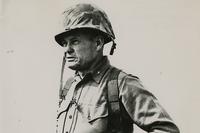NORMANDY, France -- As the clock struck midnight on June 6, 1944, the droning hum of aircraft engines broke the quiet stillness of the dark hours. A young girl, 5-year-old Danièle "Dany" Patrix Boucherie, ran to the windows of her family's house near the Allied landing site at Utah Beach to look outside. The night sky was lit up with flares carried by small parachutes, so she could see planes with gliders being pulled behind them.
"We could see as if it was daylight," Boucherie told Military.com in a recent interview. "But it was nighttime and you could hear a lot of aircraft noise, so instinctively what do you do? You open the window and see. It was fabulous."
It was a sentiment she echoed along with many of the children in Normandy that night, as recounted in the award-winning 2020 documentary film, "The Girl Who Wore Freedom." The film recounts the memory of Boucherie and other French citizens who were liberated that day. It also displays the stark contrast between how France and the United States remember D-Day.
"It was around 6:30 in the morning when the first 'firecrackers' were lit from the beaches of Sainte-Marie-du-Mont," Jean-Marie Boucherie, Dany's husband, recalled in the film. "I got up, still in my pajamas, I watched with my dad. He said to me, 'There they are.' That's all he said."
"From the bedroom windows overlooking the square you could see the silhouettes under the trees because the sun hadn't completely risen," Henri-Jean Renaud, who was 10 years old on D-Day, told the filmmakers. "We saw the glow of cigarettes, shadows, but we didn't know who they were.
"June 6, 1944, was a night of terror," Denise Leconte, who was 17 years old that day, told the filmmakers. "Around 2 a.m., we heard noise, planes; it was incredibly loud. Then we looked outside. It was bright. The night was so clear. We saw the parachutes and asked ourselves what was happening, ... as soon as the paratroopers landed, the fighting began."
Dany knew that going out in the morning would be risky, but she opened the door to her house and saw the "spectacle" of the Americans coming from Utah Beach. Tanks and soldiers were moving in the middle of the road on their way from the beach.
"When the GIs saw me, this little girl on the sidewalk, they must have thought about a little sister or a little daughter they left behind in the United States," Boucherie said. "I stood alone in front of the door, and they kept handing me chocolate and gum and candies. At 5 years old, my hands were so small, they [the candies] kept falling on the ground, so I stretched my apron out. When it was full, I emptied it into a box and went out for more. For a little girl, it was fabulous to see all that."

That first day was very different from life under Nazi occupation. Under German rule, the Boucherie family rarely ventured out. To get a little bit of bread required a special ticket. To get meat meant not just a ticket, but also showing your papers. The family wasn't allowed to leave their home otherwise. At nighttime, they had to keep their windows covered to keep the American planes from seeing the lights. That all changed on June 6, 1944.
"It was freedom; it was superb," said Boucherie. "We could walk around freely, say what we wanted, and most important, we could eat again."
"In the morning, it was euphoria," Maurice Lecoueur, who was 10 years old and living in Sainte-Mere-Eglise, told Military.com. "They offered us chocolate, rations and the like. As for me, there was an American who had me take a puff on his Camel cigarette. I coughed so much that I never smoked again in my life."
The differences in their lives between the occupation and their liberation remain with those surviving French civilians who remember D-Day. Even when the Americans set up camp to continue the campaign against Nazi Germany, children were more or less allowed to roam freely. The U.S. Army regularly fed civilian families from its mess halls while offering supplies and other aid. It even hired locals for jobs around the camp.

The persistence of those memories and the gratitude it evokes in the people of Normandy is on full display at the beginning of June every year, when locals and tourists fill France's Cotentin Peninsula, wearing full World War II-era American GI uniforms, to drive restored Jeeps and revive the feeling of those early days of Operation Overlord. It's such a spectacle that it takes many Americans by surprise.
One of those Americans was Christian Taylor, the filmmaker behind "The Girl Who Wore Freedom." She first visited Normandy for the anniversary of D-Day because her son, a soldier in the Army, was sent there for the occasion. She was surprised to discover so many "American GIs" were actually French civilians.
"I was supposed to meet my son for a parachute drop in Carentan, but I didn't know where I was supposed to go, so I was just looking for a Willys Jeep and people dressed up," Taylor told Military.com. "Then one of the Jeeps broke down in front of us, so I sent my son to help. When he came back, he told me the reenactors were all French. I soon realized how big this was. Throughout the day, I felt like I was in a time machine, and I had to figure out what was going on."
Read: The European Reenactors Paying Tribute to D-Day Veterans at Normandy
It was when she ran into Florence Boucherie that she met Dany and Jean-Marie Boucherie, who were 5 and 7 years old (respectively) on D-Day. Flo, it turned out, was Dany and Jean-Marie’s daughter. Taylor was as awestruck at their recollections of the day as she was about the reenactors who relived the day in Normandy. The families became close in the days and weeks that followed, and Taylor decided Americans needed to hear these stories.
"We don't even celebrate D-Day in the United States," Taylor said. "The French people have been doing this since 1945, inviting our veterans back, inviting the military units back that liberated them. Not a lot of people know this; military families may know, but regular citizens, I think, are not very aware of the level of gratitude the French people have."

Taylor was enamored with a photo of 5-year-old Dany wearing a dress made of American parachutes. The red and white were easy to make with just the chutes, her mother found blue material and stenciled on the stars to finish the outfit. Little Dany first wore the dress on June 6, 1945, for a ceremony to commemorate the anniversary of D-Day. When Dany grew out of the dress, her mother made her a new one.
For Taylor, this captures the lasting dedication of the French people toward the American veterans who landed that day.
"The French people lost so much but still, to this day, honor the veterans," Taylor said. "The veterans are changed by what the French do for them when they come here. They are liberated from their oppressive memories of the horrors of the war, because the French listen to them, cheer them, take pictures with them, get their autographs and take care of them."
"I think it's very important that young people know and remember this fabulous story," said Boucherie. "I would never have thought that my little dress would be the main theme of this documentary, but the film should be seen by many more people so new generations realize how much France suffered and the American people and young people, remember the soldiers who fell so that today we can be free."
World War II veterans really are transformed when they experience the French dedication to their memory. Ceo Bauer of Ithaca, Michigan, is not a Normandy veteran. He fought with the 95th Infantry Division, famous for its heroic stand against repeated German attacks at the Battle of Metz in Germany in late 1944, where Bauer was wounded. Still, he visited Normandy in 2024 at age 101. In the film, he explains the effect a visit to France has on World War II veterans.

"For we veterans who went back, it's probably the greatest experience we had in our life," he said. "When we can get to where the fighting was, the French can't honor us enough, ... but here in the USA, people are not too much interested. ... Their eyes glaze over after about two minutes. Here, for veterans of all wars, people say, 'Thank you for your service,' and that's all very fine, but they don't listen too much after that. So I'll say, 'Viva la France and God bless the USA and thank you God for being alive to relate the story.'"
"The Girl Who Wore Freedom" is available for streaming on Amazon Prime and on DVD through the film's website.
Want to Learn More About Military Life?
Whether you're thinking of joining the military, looking for post-military careers or keeping up with military life and benefits, Military.com has you covered. Subscribe to Military.com to have military news, updates and resources delivered directly to your inbox.
















